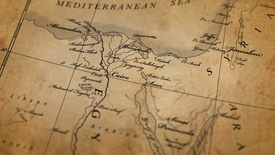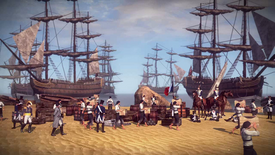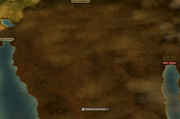The Egyptian Campaign was a military adventure by Napoleon Bonaparte, who wanted to liberate Egypt from Mameluke rule and also threaten Britain's interests in India. Napoleon had an army of 3,000 troops by the time he landed in Egypt, and it both rapidly increased and decreased as the war went on, losing his commander Jean-Baptiste Kleber to a rebellion in Cairo. However, he decimated the Mamelukes and went on to inflict severe defeats on the Ottomans and British.
Background[]

Napoleon Bonaparte lands in Egypt.
The War of the First Coalition between France and the old European nations of Austria, Great Britain, Prussia, Russia, Spain, the United Provinces, and Naples & Sicily. By 1797, all nations except for Great Britain had made peace. The British never made peace with France during the French Revolutionary Wars, and kept on fighting, creating coalitions to combat the French every couple of years.
In 1798, General Napoleon Bonaparte proposed a plan to crush the British and force them to sue for peace: he would invade Egypt and decimate the Mameluke slave-soldier rule, taking over the country in order to launch invasions of British interests in India, aiding Tipu Sultan I of Mysore in his rebellion against King George III of Great Britain. The French Directorate permitted this venture, as Napoleon was dangerously popular and might overthrow the Consul.
Napoleon faced several ominous threats should he decide to invade Egypt. Not only did the Mamluk Sultanate have immense power and a tacit agreement from the Ottoman Empire to defend them if needed, but he also faced a British base on Cyprus. The Ottomans had equipped Nizam-I-Cedit line infantry with the latest firearms, and could ferry them to Egypt from Greece and Rhodes. Also, the Bedouin tribesmen of the deserts were threatening to all parties. If he was to secure Egypt, Napoleon would not only have to capture Cairo and the other major cities, but also capture Negev, Jaffa, Acre, and the other important Ottoman strongholds on the Levant coast.

Map of Egypt in 1798
Napoleon besieged Valetta, the capital of Malta, taking it from the Knights of St. John, and used it as a base for re-provisions. The French fleet of Francois-Paul Brueys d'Aigalliers transported Napoleon, Jean-Baptiste Kleber, and Louis-Charles Antoine Desaix with 3,000 troops to Egypt, besieging Alexandria and capturing it from the Mamelukes and establishing a capital in Egypt there. From Alexandria, they expanded into Egypt, beginning the campaign.
Campaign[]
Drive on Cairo[]

The French army lands in Egypt.
The French invasion of Egypt started off with a boom, the French securing Damanhour early in June. The French army abandoned the city, exempting the region of taxes and recruiting Arab militiamen to keep public order. Next, Bonaparte, Desaix, and Kleber took Mahalla al-Kubra from the Mameluke sultan Murad Bey, who was killed in action. This certainly caused a breach in the Mameluke strength, and the leadership passed on to Ibrahim Bey, the sultan's co-ruler.
Ibrahim Bey could not help the fact that his cause was war-weary, and Mansoura surrendered without a fight, followed up by a devastating defeat at the Battle of the Pyramids, where the French square formation tactics decimated the Mameluke cavalry charges. As many as 2,000 Mamelukes were killed, and many more were wounded, with the French losing 21 killed and 260 wounded. Damietta fell when Nuruddin Kanasani surrendered the garrison after only a few shots.
Ibrahim I knew that he had to do something about the ruckuss. He led 800 troops to defend the province of Sharqia, assisting Alamgir ibn Mahmoud Al-Suri, the Mameluke commander of the Zagazig garrison. The French stormed the city with bayonets, fiercely massacring the Mameluke army. Ibrahim Bey and his reinforcements were savaged, yet were able to retreat, unlike Mahmoud, who was killed at a Frenchman's knife.
The defeat of Ibrahim Bey's army, which was the army controlling Cairo before it departed, led to the capture of the city by Napoleon, Desaix, and Kleber, whose 1,600 troops (including 120 Egyptian troops) killed all 2,118 Mameluke soldiers defending the city, breaking the Mameluke resistance and punching a large hole in their cause. Cairo was the second-largest city in the Ottoman Empire and was a center of education, as well as being an important city for the Mameluke cause.
The Road to Jaffa[]

The Sinai Peninsula
France's greatest threat by now were the Turks; Sultan Selim III was preparing an army of 10,000 troops led by Mehmed Aali and Mehmet Ali to invade Egypt, while Ottoman reinforcements were coming in from Rhodes and Greece. Napoleon left Jean-Baptiste Kleber and Desaix with 1,000 troops in Cairo while he brought his own army of 1,000 troops to drive on the city of Jaffa, which would prove to become not only an impressive stronghold, but also a buffer zone between France and the Ottomans. France forced a Mameluke retreat after a small exchange of gunfire at Bilbeis, with Ibrahim Bey and his weakling army retreating further.
Napoleon and his troops besieged the Mameluke stronghold of Arish, driving into North Sinai and into the Ottoman Empire. He took it without a fight, with Jalaluddin Al Mawalhad coming to terms with him. Napoleon continued his advance into Ottoman Syria, but halted when news of an uprising in Cairo emerged. The Cairo Rebellion, led by Alam bin Haji, was inspired by religious leaders in Qalyubia, and succeeded in taking the city and killing Kleber. Furthermore, the British fleet in Cyprus landed Sidney Smith and 300 troops in the Western Delta, threatening Alexandria.
Undaunted by these events, Napoleon formed a new army in the Sinai under Auguste Marmont, with 738 troops. Marmont besieged Suez, the capital of Helwan Province, hoping to establish a canal that would make travel to India half as short as the "around southern Africa" voyage. They faced Jalaluddin Amin, Ibrahim Bey, and Nuruddin Al Amri, who had 1,200 troops, but they decimated them and killed all but 55 troops. They lost 224 troops in the capture of Suez, resulting in the establishment of the Suez Canal. More good news came when the British force besieging Alexandria was defeated, but mopping-up operations were defeated. Jean-Baptiste Bessieres was wounded and repatriated to France in these actions. The Mamelukes returned to besiege Zagazig in early November, led by Nikusiyar Zebramani, but Tristan Deville and 351 troops held off the attackers, although being only firelock armed citizenry.
Napoleon continued his advance north, but faced the large army of Mehmed Aali and Mehmet Ali at Gaza, a city that he was besieging in Negev. However, he struck at the weak Orta mob before crushing the Palestinian Auxilliaries, spear-equipped rabble from around the area. Mehmed Aali was killed in the battle, and Ali retreated northwards.
The French Army proceeded to march northwards, securing the major strongholds along the shoreline, and they threatened to push on Rif Damashq, had it not been for the capture of Jerusalem. With the fall of most of Egypt and the Levantine coastline, France had established a position that threatened British India, but by 1801 they decided that they would withdraw following the end of the Second Coalition.
